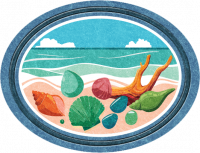AY Honor Beachcombing Requirements
1. Explain what beachcombing is and why it is an enjoyable and educational activity. Discuss the types of items you might find while beachcombing, such as shells, sea glass, driftwood, and marine debris.
2. Learn about the safety measures to take while beachcombing. Discuss the importance of being aware of tides, weather conditions, and potential hazards such as sharp objects and marine life. Explain the importance of wearing appropriate clothing and footwear.
3. Discuss the impact of human activities on coastal environments. Learn about the importance of protecting marine ecosystems and the role of beachcombing in environmental conservation. Explain the principles of “leave no trace” and how to minimize your impact on the beach.
4. Look up and discuss at least two Bible verses that mention the sea or the shore. Reflect on their significance and what they can teach us about the value of creation and our responsibility to care for the environment.
5. Identify and describe at least five different types of items you might find while beachcombing. Include natural items such as shells, sea glass, driftwood, and seaweed, as well as man-made items like plastic debris and lost fishing gear.
6. Learn to identify at least five different types of shells commonly found on beaches. Describe their characteristics and how to distinguish them from other shells and marine objects.
7. Discuss the formation of sea glass and driftwood. Explain how these items are created and what makes them unique. Learn how to safely collect and clean sea glass and driftwood.
8. Research the sources and effects of marine debris and pollution. Discuss the importance of cleaning up beaches and how beachcombing can contribute to reducing marine litter. Participate in a beach cleanup activity.
9. Participate in a beachcombing field trip. Spend at least two hours exploring a local beach, collecting items, and recording your findings in a notebook. Note the types of items found, their locations, and any observations about the beach environment.
10. Create a project using the items you collected during your beachcombing field trip. This could be a piece of art, a craft, or a display that showcases your finds. Share your project with your group and explain the significance of the items you used.



